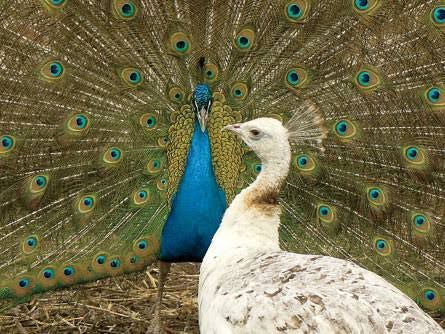The peacock, with its vibrant plumage and striking displays, has captivated humans for centuries. This dazzling bird, revered in various cultures across the world, has been imbued with rich symbolism, often carrying a complex and multifaceted meaning. Beyond its aesthetic appeal, the peacock represents a range of concepts, from immortality and divine power to vanity and deceit. In this article, we will explore the origins of the peacock’s symbolism and its significance in different cultures, as well as its spiritual meanings and influence on art and design.
Pride and Majesty: The Peacock in Mythology and Folklore

The peacock’s symbolism is intricately woven into the fabric of ancient mythology and religious traditions. In Hindu mythology, the peacock is closely associated with Lord Krishna, the eighth avatar of Vishnu. It symbolizes his divine power and beauty, and its feathers are often used to adorn his images. It is believed that Krishna’s consort, Radha, wore peacock feathers in her hair, further solidifying the connection between the bird and love.
In ancient Greece, the peacock was sacred to the goddess Hera, wife of Zeus. She is often depicted with a peacock by her side, symbolizing her majesty, power, and even her jealous nature. In Greek mythology, the peacock’s tail feathers are said to have originated from the eyes of Argus Panoptes, a giant with a hundred eyes who was tasked with guarding Hera’s rival, Io. When Argus was killed by Hermes, Hera took his hundred eyes and placed them on the tail of the peacock as a symbol of her divine watchfulness.
The peacock also holds a significant place in Chinese mythology, where it is seen as a symbol of power, dignity, and beauty. In Chinese folklore, the bird is believed to have the ability to control evil forces and bring peace to its surroundings. It is also a symbol of longevity and prosperity, with its feathers often used in decorative items and traditional clothing.
The Peacock’s Symbolic Significance in Different Cultures

The peacock holds immense symbolic significance in various cultures across the world. In Christianity, it represents resurrection and immortality, as its molted feathers are believed to regrow brighter and more beautiful each year. According to Christian beliefs, the peacock’s ability to shed its feathers and grow new ones symbolizes the cycle of death and rebirth.
In Buddhism, the peacock symbolizes purity and enlightenment. The bird’s graceful movements and colorful plumage represent the path towards spiritual awakening and transcendence. In Buddhist art and iconography, the peacock is often depicted alongside the Buddha or other deities, representing their pure and enlightened nature.
In Native American culture, the peacock is seen as a symbol of protection and warding off negative energy. Feathers from the bird are believed to bring good luck and positive energies, making them highly valued in tribal rituals and ceremonies.
Spiritual Meanings of the Peacock: Immortality, Rebirth, and Enlightenment

The peacock’s symbolism goes beyond cultural and mythological references; it also holds significant spiritual meanings. In Hinduism, the bird is associated with immortality, as its feathers are believed to be incorruptible and indestructible. In many Hindu temples, peacock motifs can be found on pillars and walls, symbolizing eternal life and transcendence.
In Chinese culture, the peacock is linked with the concept of yin and yang – the balance between light and dark, feminine and masculine energies. Its dazzling display of colors represents the harmony between opposing forces, while its fanning tail symbolizes abundance and wealth.
In some spiritual practices, the peacock feather is used for aura cleansing and chakra balancing. Its vibrant and iridescent colors are believed to bring balance and harmony to the energy centers of the body, enhancing spiritual well-being and inner peace.
The Peacock as a Symbol of Protection and Good Luck
The peacock’s feathers are often seen as a symbol of protection and good luck in various cultures. In ancient Egypt, the bird was associated with the god Horus, who was believed to have the power to ward off evil spirits and protect the pharaohs. It is also a sacred bird in Iranian mythology, where its feathers are used in talismans for protection against evil forces.
In modern times, many believe that keeping a peacock feather in their home or workplace can bring good luck and prosperity. The mesmerizing patterns and shimmering colors of the feathers are said to attract positive energies and abundance.
Peacock Feathers in Art and Design: A Lasting Symbol of Beauty

The peacock’s symbolism has not only influenced mythology and spirituality but also art and design. The intricate patterns and vibrant colors of its feathers have been a source of inspiration for artists and designers throughout history. From ancient civilizations to modern-day fashion, the peacock continues to be a timeless symbol of beauty and grace.
In medieval manuscripts and Renaissance paintings, the peacock is often depicted as a symbol of vanity and pride. Its luxurious and exotic appearance was used as a contrast to religious themes, representing worldly desires and material possessions.
In the world of fashion, the peacock’s feathers have been used in haute couture and costume design for centuries. From elaborate headpieces to intricately embroidered garments, the bird’s feathers add a touch of glamour and opulence to any ensemble.
Conclusion
In conclusion, the peacock’s symbolism is deeply rooted in ancient mythology, religion, and culture. This magnificent bird has been revered for its beauty and grace, and its symbolism has evolved over time, holding different meanings in different parts of the world. From representing divine power and immortality to vanity and deceit, the peacock remains a fascinating symbol that continues to inspire and captivate us. Its influence can be seen in various aspects of our lives, from art and design to spirituality and good luck charms. The peacock truly is a symbol of beauty, pride, and so much more.
